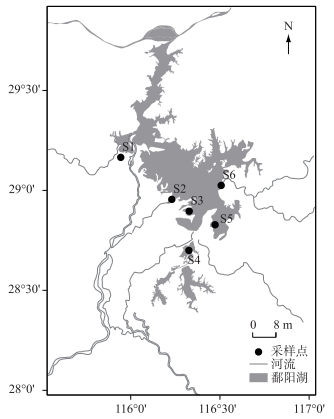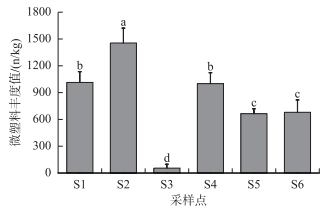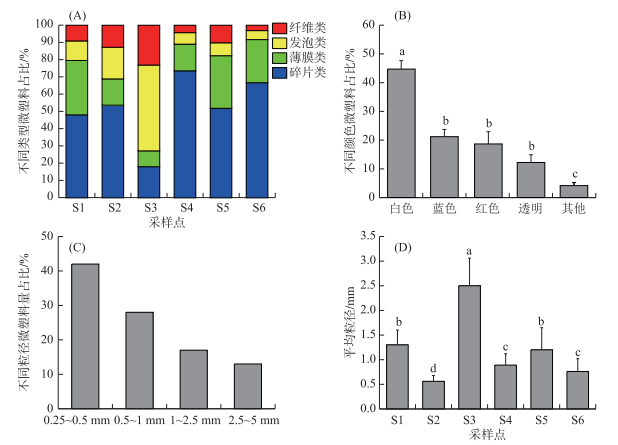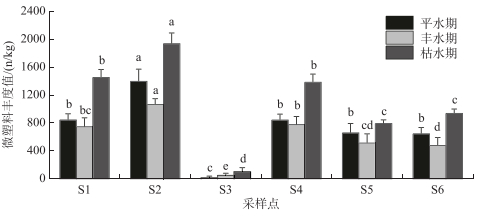(2: 江西师范大学鄱阳湖湿地与流域研究教育部重点实验室, 南昌 330022)
(2: Key Laboratory of Lake Poyang Wetland and Watershed Research, Ministry of Education, Jiangxi Normal University, Nanchang 330022, P. R. China)
微塑料(粒径 < 5 mm)是海洋环境中一种新型的污染物,被科学家称作“海洋PM2.5”[1].微塑料污染已经与全球气候变化、臭氧耗竭和海洋酸化并列为重大全球环境问题,并成为近年来全球范围内一个新的生态污染研究热点[2].我国作为世界上最大的塑料生产国和使用国,2015年产生了8950万吨塑料垃圾,占全球的27.8 % [3],而只有9 %的塑料垃圾被回收,绝大部分的塑料垃圾被填埋、焚烧,最终在自然环境中分解成微小的塑料颗粒[4].相比于大型塑料垃圾,微塑料颗粒由于粒径小、类型多、表面结构复杂,其在内陆环境中的来源、运输和对生物的影响越来越受到关注[5].微塑料主要来源于工业制备成微米级的初生塑料颗粒[6]和工农业、日常生活的大型塑料碎片裂解形成的次生塑料颗粒[7],这些具有难降解、持久性和稳定性等化学特性的塑料颗粒一旦进入到自然环境中,可以存在数十年甚至几千年[8].微塑料还可被水生动物包括浮游生物、鱼类和水鸟误食,导致肠道堵塞、激素水平改变甚至窒息死亡[9-10],而且微塑料作为有机污染物和重金属迁移运输的载体,可通过食物链逐渐传递富集,最终危及到人类的健康[11].
湖岸带是陆地与湖泊相互作用的交界地带,也是人类活动最为活跃的敏感地区之一.一方面,人类活动产生的大量塑料垃圾、污水在岸滩汇集[12],或可能通过河流的冲刷作用向湖泊输送并在湖岸带淤积[13];另一方面,水体中漂浮的大量塑料垃圾在水动力及风力作用下易迁移汇聚至岸滩附近,并被湿地植物所阻拦.这些塑料碎片经过光降解或水冲击作用,脆化成粒径更小型的塑料颗粒沉积在湖岸带表层沉积物中.目前,为了调查分析微塑料在湖泊湿地中具体的分布、迁移路径及其污染状况,国际上已有较多关于湖泊地区微塑料污染的调查研究,如意大利的波尔塞纳湖和丘西湖[14],北美洲的安大略湖[15]和印度的文伯纳德湖[16]等.此类研究在国外虽已有大量报道,但在国内有关湖泊微塑料污染的研究主要针对青藏高原的内陆湖泊[17]、青海湖[18]、洞庭湖[19]、滇池[20]和太湖[21-22]进行过调查,而对于鄱阳湖沉积物微塑料的时空分布尚处于未知状态.本文以鄱阳湖“五河”入湖口为研究区域,并选择鄱阳湖南矶山国家级自然保护区作为对照,以沉积物中的微塑料为研究对象,初步研究微塑料丰度、粒径、类型、形貌特点及其时空分布特征,探讨鄱阳湖湿地岸滩沉积物中微塑料的污染特征及其主要来源,为控制塑料垃圾管理提供一定的依据.
1 材料与方法 1.1 研究区概况鄱阳湖(28°22′~29°45′N,115°47′~116°45′E)位于长江中下游交接处南岸、江西省的北部,是我国最大的内陆淡水湖泊,也是国际上重要的湿地[23].鄱阳湖是一个过水型、吞吐型、季节性的湖泊,其水位变化受“五河”(赣江、抚河、信江、饶河、修河)绝大多数地表径流及长江来水的双重影响,经调蓄后由出湖口注入长江,五大支流入湖口岸滩沉积物的微塑料污染状况直接决定着鄱阳湖的生态环境安全进而影响长江中下游的水质状况和经济发展[24].近年来,随着“五河”流域的社会经济发展及资源的开发利用,来自农业面源、工业污染源和城镇生活污染负荷逐年增加,鄱阳湖面临的环境污染问题也日益突出[25].而鄱阳湖的南矶山是国家级自然保护区,保护区内地广人稀,自然资源极为丰富,是重要的水鸟越冬地和中继站[26],环境污染来源相对较少,可作为对照区.因此,选择鄱阳湖“五河”入湖口及南矶山湖岸带作为微塑料污染的调查区域具有重要的生态学意义.
1.2 实验设计与样品采集选取修河入湖口吴城(S1),赣江中支入湖口朱港(S2),南矶山(S3),抚河入湖口渡头乡(S4),信江西支入湖口瑞洪镇(S5),饶河入湖口龙口(S6)6个岸滩地进行研究(图 1).于2016年3月、7月、12月(分别为平水期、丰水期和枯水期)对以上样点采集样品,随机选取岸滩附近若干个50 cm×50 cm的正方形样方,用不锈钢铲采集表层(0~5 cm)沉积物样品(每岸滩各取3个平行样,样点间距50 m),装入铝箔采样袋中密封保存带回实验室,置于避光处自然风干后备用.

|
图 1 研究区采样点位置 Fig.1 Location of sampling sites in study area |
沉积物中微塑料的分离方法是依据密度分离原理将轻组分微塑料与重组分杂质进行分离,本实验在周倩等[27]及Claessens等[28]发明的微塑料分离-浮选装置的基础上,对沉积物样品的连续分离浮选方法进行了改进[29](图 2).

|
图 2 微塑料连续流动分离浮选装置示意图(1-溶液存储桶;2-玻璃管;3-蠕动泵;4-空气泵;5-气体流量计;6-溢流收集杯;7-样品杯;8-固定支架;9-磁力搅拌器;10-蠕动泵;11-振动筛;12-回收槽) Fig.2 Schematic for an apparatus of continuous flow separation flotation for microplastics |
称取1 kg沉积物样品(干重)进行浮选分离,先将饱和密度1.2 g/ml的NaCl溶液持续通入沉积物中进行初次分离浮选,初次分离浮选后收集到的微塑料仍带有一些有机质和泥土,再用上述NaCl溶液进行分离,同时加入35 % H2O2溶液除去有机质并收集上清液,用饱和的NaCl溶液对1~5和 < 1 mm粒径范围的颗粒回收率分别达到97.5 %和95.5 % [30].用真空抽滤装置过滤,滤膜采用孔径为2 μm的醋酸-纤维素滤膜,真空抽滤过后,将滤膜置于玻璃培养皿中备用.为了防止背景污染,微塑料的分离提取和观察操作均在洁净密闭的环境中进行,同时用>0.25 mm的石英砂作为背景样本进行微塑料的分离提取与观测.
1.4 微塑料的鉴定与分析滤膜置于金相显微镜(上海精密仪器公司)下观察各类微塑料的外观及形态特征,鉴定微塑料的类型、颜色分类,使用金相显微镜时先在10~40倍放大倍数下初步观察,分离出的微塑料粒径均小于5 mm,对于不确定的颗粒或粒径小于1 mm的微塑料,借助型号为S-3400N台式扫描电镜(SEM,日本日立电子)进行进一步鉴定.采用Nano Measuer 1.2软件统计各样点微塑料的丰度值(n/kg,按沉积物干重单位kg内含有微塑料的数量计)及各类型微塑料的比例,各类型微塑料以微塑料的最长一边的长度记为粒径大小[27].
1.5 数据处理实验中使用的采样点图采用ArcGIS 10.5软件进行绘制,实验数据分析图使用Origin 9.0软件进行绘制,并利用SPSS 20.0软件进行显著性检验,P < 0.05表示差异具有显著性统计学意义.
2 结果 2.1 不同区域沉积物中微塑料的丰度分布规律对研究区6个样点沉积物进行微塑料的浮选分离,结果表明各采样点沉积物样品中均有检出微塑料,统计6个样点的微塑料(< 5 mm)丰度值范围在14~1632 n/kg,平均丰度值为811.11 n/kg,对各样点的微塑料丰度值比较,结果为朱港(S2)>吴城(S1)>渡头乡(S4)>龙口(S6)>瑞洪镇(S5)>南矶山(S3)(图 3).以朱港的微塑料丰度值最高,达到1455 n/kg;南矶山的微塑料丰度值为55 n/kg,显著低于朱港、吴城、渡头乡、瑞洪镇、龙口,其中朱港的微塑料丰度值是南矶山的26.6倍.吴城的微塑料丰度值与渡头乡相比差异不显著,瑞洪镇与龙口相比差异也不显著.

|
图 3 研究区沉积物中微塑料丰度(不同小写字母表示数据存在显著差异(P < 0.05),下同) Fig.3 Microplastic abundance value of sediments in study area (Different lowercase letters indicate significant differences at the P < 0.05 level) |
研究区的微塑料类型分析结果如图 4所示,分离结果发现所有样点均存在碎片类、发泡类、薄膜类和纤维类4种类型的微塑料.在所调查样点中,碎片类微塑料占比最高,占51.95 %,其次是薄膜类微塑料,占26.20 %,发泡类和纤维类分别占到16.52 %和5.33 %.碎片类微塑料多为块状或条状的一些塑料编织袋碎片和硬质塑料碎片(图 4a),因其粉化度和塑化性较高,所以在自然环境下裂解的小碎片数量最多,表明碎片类颗粒以次生微塑料为主;薄膜类微塑料多为大小均匀的无规则片状(图 4b),质地轻且易卷曲;纤维类微塑料主要呈细长线型或两头有卷须(图 4c),在自然环境中主要来源于渔线或衣物纤维;发泡类微塑料以白色泡沫塑料球状物为主(图 4d),粒径相对较大,质地轻、密度小且在环境中易迁移.

|
图 4 沉积物中不同类型的微塑料(金相显微镜下放大40倍) Fig.4 Different microplastic samples in the sediments (Magnified 40 times under metallographic microscope) |
4种微塑料类型在不同样点所占比例如图 5A所示,除南矶山外,碎片类微塑料均高于薄膜类、发泡类和纤维类微塑料,且所占比例均高于48.1 %,其中渡头乡高达73.6 %.南矶山以发泡类微塑料为主,所占比例为50.2 %.

|
图 5 研究区沉积物中微塑料污染物的主要特征 Fig.5 The surface properties of microplastic in the sediments of the study area |
研究区沉积物中微塑料的颜色分析结果如图 5B所示,分离出的微塑料以白色、蓝色、红色和透明为主,其在数量上分别占总量的44.5 %、21.0 %、18.5 %和12.0 %,剩余4.0 %为黑色、黄色、绿色等其他颜色.白色微塑料显著高于蓝色、红色、透明和其他颜色.碎片类微塑料以乳白色、蓝色和淡蓝色为主,薄膜类主要以透明、半透明和黑色为主,发泡类主要以白色为主,纤维类以蓝色、红色为主.不同类型的微塑料因其来源广泛和外界环境的干扰,使得微塑料的颜色有着很大的差异.
2.3.3 各区域微塑料的粒径分布研究区各样点沉积物中微塑料的粒径分析结果如图 5C所示,统计6个采样点的微塑料粒径范围主要在0.25~5.00 mm之间,其中0.25~0.50和0.50~1.00 mm粒径的微塑料数量占总数的百分比分别为42 %和28 %,1.00~2.50 mm粒径的微塑料百分比为17 %,2.50~5.00 mm粒径的微塑料百分比为13 %.微塑料粒径分布的总体趋势表现为,随着微塑料粒径的减小其在沉积物样品中累积的数量呈增加趋势,分离的样品中约70 %的微塑料粒径 < 1.00 mm.
对研究区微塑料平均粒径进行分析结果如图 5D所示,南矶山的微塑料平均粒径要显著高于其他样点,吴城与瑞洪镇的微塑料平均粒径差异不显著,渡头乡与龙口的微塑料平均粒径差异也不显著,朱港的微塑料平均粒径最小,仅0.58±0.12 mm,“五河”入湖口的微塑料平均粒径均较南矶山小.
2.4 鄱阳湖不同水期微塑料的丰度变化规律受长江干流及鄱阳湖“五河”流域的汛期影响,鄱阳湖水位呈现周期性的变化规律.长江干流主汛期一般为7-9月,鄱阳湖“五河”主汛期为4-6月,后汛期为7-9月. 4-6月,随鄱阳湖水系(“五河”)洪水入湖上涨,7-9月因长江洪水顶托或倒灌而维持高水位,10月才稳定退水,逐渐进入枯水期.因此,本文分别选取平水期(3月)、丰水期(7月)和枯水期(12月)采集样品,分析不同水期微塑料的分布及丰度变化.通过与表 1中鄱阳湖3个不同水位期水文参数对比,可以发现表层沉积物中微塑料的丰度与鄱阳湖的水文变化有着一定的关联.鄱阳湖丰水期水量达180亿m3,水面面积为3800 km2,水位16 m,各参数均显著高于枯水期(P < 0.05);不同水期微塑料的平均丰度值分别为丰水期598.83 n/kg,枯水期1105.00 n/kg,平水期为729.50 n/kg, 丰水期显著低于枯水期(P < 0.05);丰水期与平水期相比虽存在差异但不显著.可能是因为丰水期汛期水力作用下对表层沉积物的冲刷较大,沉积物中的微塑料随水位高涨而动态迁移或悬浮于水体中;进入枯水期后,在静态下微塑料集聚于表层沉积物中.
| 表 1 鄱阳湖各水位期水文参数 Tab. 1 Hydrological parameter of Lake Poyang in each water level period |
不同采样点、不同水期微塑料的丰度变化如图 6.其中,南矶山(S3)3个水期的微塑料丰度均较低,不同水期的差异不显著;朱港是微塑料污染最严重的区域,在3个不同水期朱港(S2)的微塑料丰度均显著(P < 0.05)高于其他各样点同期.其他各样点不同水期微塑料的丰度存在一定差异,吴城、瑞洪镇、渡头乡和龙口4个样点的微塑料丰度在平水期差异均不显著;但在丰水期和枯水期,吴城和渡头乡的微塑料丰度均显著高于瑞洪镇和龙口(P < 0.05),吴城与渡头乡的微塑料丰度对比有差异但均不显著,瑞洪镇与龙口的微塑料丰度对比有差异但也不显著.各样点微塑料污染物主要积聚在枯水期,其次是平水期,丰水期微塑料污染最轻.

|
图 6 不同水位期微塑料丰度 Fig.6 Microplastic abundance value of sediments in each water level period |
鄱阳湖沉积物中微塑料平均丰度值监测结果与内陆水域和海洋环境的微塑料丰度比较,差异较大.鄱阳湖的废塑料平均丰度(811.11 n/kg)与北大西洋副热带环流(1414 n/kg)[32]、南大西洋副热带环流(1534 n/kg)[33]、地中海西北部地区(1204 n/kg)[34]相近,略高于西藏高原内陆湖泊(763 n/kg)[17]、青海湖(710 n/kg)[18]、太湖(234.6 n/kg)[19]和三峡库区(382 n/kg)[35].鄱阳湖入湖口微塑料最高丰度值与闽江(1970 n/kg)、椒江(1776 n/kg)相近[36],远低于汉江(3844 n/kg)[37]和长江(3420 n/kg)[38].与其他区域的微塑料丰度值相比,鄱阳湖“五河”入湖口沉积物的微塑料污染水平处于中等水平.
3.2 鄱阳湖微塑料污染的来源入湖口是研究湖泊微塑料污染的关键区域,沿河输入的塑料垃圾是鄱阳湖微塑料污染的重要来源[39].朱港的微塑料丰度值最高,南矶山的微塑料丰度值最低.其原因一方面是赣江中支来水汇入鄱阳湖区域水网密布、流速减低所携带泥沙大量沉积,微塑料在泥沙沉积物淤积位点丰度较高;另一方面是赣江中支流所经区域广、人口稠密,生活垃圾和污水的排放导致微塑料来源广泛,而南矶山是国家级自然保护区,人为活动的影响少,结果表明人类活动产生的塑料垃圾是微塑料的重要来源.
从时间分布看,鄱阳湖在不同水位期的微塑料丰度与长江口不同季节微塑料丰度基本一致,7月丰水期的微塑料丰度显著低于12月枯水期的微塑料丰度,雨季降水和水位上涨冲刷对沉积物中微塑料污染的积聚有着减缓作用.韩国洛东江河口沉积物中雨季后(9月)的微塑料丰度要显著高于雨季前(5月)[40];印度果阿海滩的海滩沉积物中微塑料丰度值表现为春季(3月)>夏季(7月)>冬季(12月)[41],且春季的微塑料丰度是冬季的6~26倍;热带河口的微塑料丰度与高降水量呈正相关关系[42],雨季过后,微塑料被水流和生物群落冲刷,其微塑料丰度达到最低值.结果表明微塑料的分布随季节的分布而有差异,地表水径流是微塑料运输和沉积的驱动力.
3.3 鄱阳湖微塑料污染物的特性不同研究区的微塑料类型有较大差异,鄱阳湖和长江口都分离出了碎片类和纤维类微塑料两种类型,但鄱阳湖微塑料以碎片类为主(< 5.00 mm),而长江口微塑料以纤维类为主(< 0.30 mm)[43-44].渤海和黄海海岸滩以颗粒类为主(< 1.00 mm)[45],比利时海岸微塑料以碎片类为主(38 μm~1.00 mm)[46],新加坡红树林以纤维类为主(<0.02 mm)[47].通过上述研究区域对比表明不同区域的主要微塑料类型不同,其原因可能是微塑料来源和各种塑料材质特性不同.
鄱阳湖沉积物中检测出的微塑料粒径范围为0.25~5.00 mm,70 %的微塑料粒径 < 1.00 mm,这与生物体内的微塑料粒径相似,比如,鄱阳湖蛤蜊中的微塑料粒径主要在0.25~1.00 mm之间[48],珠江口牡蛎体内83.9 %的微塑料粒径在0.02~5.00 mm之间[49],北太平洋中央环流地区鱼体内35 %的微塑料粒径范围为1~2.79 mm[50].通过以上研究发现,微塑料可以通过食物链在生物体内逐渐富集.
鄱阳湖沉积物中微塑料鉴定出的颜色以白色、蓝色、红色和透明为主,这与印度孟买海滩[51]、长江河口[43]的结果相似.着色是提高塑料制品吸引力的一种普遍做法,因此,塑料在成型或挤压成型之前,会添加颜色母料添加剂到大部分的聚合塑脂中[52],如包装袋、衣服布料、薄膜和鱼线[53].由于食物的相似性,进入到水体中的这些彩色的塑料颗粒一定程度上会刺激生物的视觉从而导致其误食[54].因此,分析沉积物中不同微塑料的颜色分布特性具有一定的重要意义.
4 结论1) 鄱阳湖“五河”入湖段沉积物中微塑料(< 5 mm)平均丰度值达到811.11 n/kg,各河口调查区间的微塑料丰度存在明显差异,表现为朱港(赣江中支入湖口)>吴城(修河入湖口)>渡头乡(抚河入湖口)>龙口(饶河入湖口)>瑞洪镇(信江西支入湖口)>南矶山(国家级自然保护区,对照区),表现出人类活动对微塑料污染所起的主要决定作用.
2) 研究区微塑料的类型主有碎片类、薄膜类、纤维类和发泡类4种.其中碎片类微塑料比例占51.95 %,碎片类微塑料多为块状或条状的一些塑料编织袋碎片和硬质塑料碎片,以次生微塑料为主.
3) 各入湖段沉积物中微塑料的颜色以白色、蓝色、红色和透明为主,粒径范围为0.25~5 mm,70 %的微塑料粒径 < 1 mm.
4) 不同水期研究区各采样点沉积物中微塑料平均丰度值呈现为枯水期1105.00 n/kg>平水期729.50 n/kg >丰水期598.83 n/kg,不同水期沉积物中微塑料的丰度变化与水位变化表现出一致性,地表水径流是微塑料运输和沉积的驱动力.
| [1] |
Wang JY, Lin XZ. Global ocean governance in addressing plastic and microplastic pollution. Pacific Journal, 2018, 26(4): 79-87. [王菊英, 林新珍. 应对塑料及微塑料污染的海洋治理体系浅析. 太平洋学报, 2018, 26(4): 79-87.] |
| [2] |
Law KL, Thompson RC. Oceans. Microplastics in the seas. Science, 014, 345(6193): 144-145. |
| [3] |
Plastics Europe. Plastics-the facts 2016: An analysis of European plasticsproduction, demand and waste data, 2016. http://www.plasticseurope.org.
|
| [4] |
Geyer R, Jambeck JR, Law KL. Production, use, and fate of all plastics ever made. Science Advances, 2017, 3(7): e1700782. DOI:10.1126/sciadv.1700782 |
| [5] |
Cole M, Lindeque P, Halsband C et al. Microplastics as contaminants in the marine environment: A review. Marine Pollution Bulletin, 2011, 62(12): 2588-2597. DOI:10.1016/j.marpolbul.2011.09.025 |
| [6] |
Cooper DA, Corcoran PL. Effects of mechanical and chemical processes on the degradation of plastic beach debris on the island of Kauai, Hawaii. Marine Pollution Bulletin, 2010, 60(5): 650-655. DOI:10.1016/j.marpolbul.2009.12.026 |
| [7] |
Liu Q, Xu XD, Huang W et al. Research advances on the ecological effects of microplastic pollution in the marine environment. Acta Ecologica Sinica, 2017, 37(22): 7397-7409. [刘强, 徐旭丹, 黄伟等. 海洋微塑料污染的生态效应研究进展. 生态学报, 2017, 37(22): 7397-7409.] |
| [8] |
Cózar A, Echevarría F, González-Gordillo JI et al. Plastic debris in the open ocean. Proc Natl Acad Sci USA, 2014, 111(28): 10239-10244. DOI:10.1073/pnas.1314705111 |
| [9] |
Chae Y, An YJ. Effects of micro- and nanoplastics on aquatic ecosystems: Current research trends and perspectives. Marine Pollution Bulletin, 2017, 124: 624-632. DOI:10.1016/j.marpolbul.2017.01.070 |
| [10] |
Galloway TS, Cole M, Lewis C. Interactions ofmicroplastic debris throughout the marine ecosystem. Nature Ecology & Evolution, 2017, 1(5): 116-122. |
| [11] |
Teuten EL, Saquing JM, Knappe DRU et al. Transport and release of chemicals from plastics to the environment and to wildlife. Philos Trans R Soc Lond B Biol Sci, 2009, 364(1526): 2027-2045. DOI:10.1098/rstb.2008.0284 |
| [12] |
Browne MA, Crump P, Niven SJ et al. Accumulation of microplastic on shorelines woldwide: Sources and sinks. Environmental Science & Technology, 2011, 45: 9175-9179. |
| [13] |
Zhang K, Gong W, Lv J et al. Accumulation of floating microplastics behind the Three Gorges Dam. Environmental Pollution, 2015, 204: 117-123. DOI:10.1016/j.envpol.2015.04.023 |
| [14] |
Fischer EK, Paglialonga L, Czech E et al. Microplastic pollution in lakes and lake shoreline sediments-A case study on Lake Bolsena and Lake Chiusi (central Italy). Environmental Pollution, 2016, 213: 648-657. DOI:10.1016/j.envpol.2016.03.012 |
| [15] |
Ballent A, Corcoran PL, Madden O et al. Sources and sinks of microplastics in Canadian Lake Ontario nearshore, tributary and beach sediments. Marine Pollution Bulletin, 2016, 110(1): 383-385. DOI:10.1016/j.marpolbul.2016.06.037 |
| [16] |
Sruthy S, Ramasamy EV. Microplastic pollution in Vembanad Lake, Kerala, India: The first report of microplastics in lake and estuarine sediments in India. Environmental Pollution, 2017, 222: 315-322. DOI:10.1016/j.envpol.2016.12.038 |
| [17] |
Zhang K, Su J, Xiong X et al. Microplastic pollution of lakeshore sediments from remote lakes in Tibet plateau, China. Environmental Pollution, 2016, 219: 450-455. DOI:10.1016/j.envpol.2016.05.048 |
| [18] |
Xiong X, Zhang K, Chen X et al. Sources and distribution of microplastics in China's largest inland lake-Qinghai Lake. Environmental Pollution, 2018, 235: 899-906. DOI:10.1016/j.envpol.2017.12.081 |
| [19] |
Wang W, Yuan W, Chen Y et al. Microplastics in surface waters of Dongting Lake and Hong Lake, China. Science of the Total Environment, 2018, 633: 539-545. DOI:10.1016/j.scitotenv.2018.03.211 |
| [20] |
Zhang GS, Liu YF. The distribution ofmicroplastics in soil aggregate fractions in southwestern China. Science of the Total Environment, 2018, 642: 12-20. DOI:10.1016/j.scitotenv.2018.06.004 |
| [21] |
Su L, Xue Y, Li L et al. Microplastics in Taihu Lake, China. Environmental Pollution, 2016, 216: 711-719. DOI:10.1016/j.envpol.2016.06.036 |
| [22] |
Jabeen K, Su L, Li J et al. Microplastics and mesoplastics in fish from coastal and fresh waters of China. Environmental Pollution, 2016, 221: 141-149. |
| [23] |
Wang P, Chen B, Zhang H. High throughput sequencing analysis of bacterial communities in soils of a typical Lake Poyang wetland. Acta Ecologica Sinica, 2017, 37(5): 1650-1658. [王鹏, 陈波, 张华. 基于高通量测序的鄱阳湖典型湿地土壤细菌群落特征分析. 生态学报, 2017, 37(5): 1650-1658.] |
| [24] |
Huang X, Hu B, Wang P et al. Microbial diversity in lake-river ecotone of Lake Poyang, China. Environmental Earth Sciences, 2016, 75(11): 1-7. |
| [25] |
Zhang J, Huang XL, Zhang T et al. Effects of heavy metal pollution on microbial community and diversity in lake-river ecotone of Lake Poyang. J Lake Sci, 2018, 30(3): 640-649. [张建, 黄小兰, 张婷等. 鄱阳湖河湖交错带重金属污染对微生物群落与多样性的影响. 湖泊科学, 2018, 30(3): 640-649. DOI:10.18307/2018.0306] |
| [26] |
Zhang XR, Shao MQ, Xu T et al. Study on bird diversity in Nanjishan National Nature Reserve, Jiangxi Province during Non-breeding Period. Sichuan Journal of Zoology, 2011, 30(4): 649-653. [章旭日, 邵明勤, 许婷等. 江西南矶山国家级自然保护区非繁殖期鸟类多样性研究. 四川动物, 2011, 30(4): 649-653. DOI:10.3969/j.issn.1000-7083.2011.04.035] |
| [27] |
Zhou Q, Zhang HB, Li Y et al. Progress on microplastics pollution and its ecological effects in the coastal environment. Chinese Science Bulletin, 2015, 60: 3210-3220. [周倩, 章海波, 李远等. 海岸环境中微塑料污染及其生态效应研究进展. 科学通报, 2015, 60(33): 3210-3220.] |
| [28] |
Claessens M, Van CL, Vandegehuchte MB et al. New techniques for the detection of microplastics in sediments and field collected organisms. Marine Pollution Bulletin, 2013, 70: 227-233. DOI:10.1016/j.marpolbul.2013.03.009 |
| [29] |
Jian MF, Zhou LY, Yu HP et al. Separation of microplastics from the sediments in the Wetland of the estuary of Raohe River in Longkou of Lake Poyang and their surface microscopic features. Acta Scientiae Circumstantiae, 2018, 38(2): 579-586. [简敏菲, 周隆胤, 余厚平等. 鄱阳湖-饶河入湖段湿地底泥中微塑料的分离及其表面形貌特征. 环境科学学报, 2018, 38(2): 579-586.] |
| [30] |
Nuelle MT, Dekiff JH, Remy D et al. A new analytical approach for monitoring microplastics in marine sediments. Environmental Pollution, 2014, 184(1): 161-169. |
| [31] |
Ji WT, Ge G, Li HH et al. Lake Poyang—Terrain, hydrology, vegetation. Beijing: Science Press, 2017. [纪伟涛, 葛刚, 李海辉等. 鄱阳湖——地形, 水文, 植被. 北京: 科学出版社, 2017.]
|
| [32] |
Law KL, Morétferguson S, Maximenko NA et al. Plastic accumulation in the North Atlantic Subtropical Gyre. Science, 2010, 329(5996): 1185-1188. DOI:10.1126/science.1192321 |
| [33] |
Eriksen M, Maximenko N, Thiel M et al. Plastic pollution in the South Pacific subtropical gyre. Marine Pollution Bulletin, 2013, 68(1/2): 71-76. |
| [34] |
Collignon A, Hecq JH, Glagani F et al. Neustonic microplastic and zooplankton in the North Western Mediterranean Sea. Marine Pollution Bulletin, 2012, 64(4): 861-864. DOI:10.1016/j.marpolbul.2012.01.011 |
| [35] |
Di M, Wang J. Microplastics in surface waters and sediments of the Three Gorges Reservoir, China. Science of the Total Environment, 2017, 616: 1620-1627. |
| [36] |
Zhao S, Zhu L, Li D. Microplastic in three urban estuaries, China. Environmental Pollution, 2015, 206: 597-604. DOI:10.1016/j.envpol.2015.08.027 |
| [37] |
Wang W, Ndungu AW, Li Z et al. Microplastics pollution in inland freshwaters of China: A case study in urban surface waters of Wuhan, China. Science of the Total Environment, 2016, 575: 1369-1374. |
| [38] |
Zhu XT, Yi J, Qiang LY et al. Distribution and settlement of microplastics in surface sediment of Yangtze Estuary. Environmental Science, 2018, 39(5): 2067-2074. [朱晓桐, 衣俊, 强丽媛等. 长江口潮滩表层沉积物中微塑料的分布及沉降特点. 环境科学, 2018, 39(5): 2067-2074.] |
| [39] |
Klein S, Worch E, Knepper TP. Occurrence and spatial distribution of microplastics in river shore sediments of the Rhine-Main area in Germany. Environmental Science & Technology, 2015, 49(10): 6070-6076. |
| [40] |
Lee J, Hong S, Song YK et al. Relationships among the abundances of plastic debris in different size classes on beaches in South Korea. Marine Pollution Bulletin, 2013, 77(2): 349-354. |
| [41] |
Veerasingam S, Saha M, Suneel V et al. Characteristics, seasonal distribution and surface degradation features of microplastic pellets along the Goa coast, India. Chemosphere, 2016, 159: 496-505. DOI:10.1016/j.chemosphere.2016.06.056 |
| [42] |
Lima ARA, Barletta M, Costa MF. Seasonal distribution and interactions between plankton andmicroplastics in a tropical estuary. Estuarine Coastal & Shelf Science, 2015, 165: 213-225. |
| [43] |
Zhao S, Zhu L, Wang T et al. Suspended microplastics in the surface water of the Yangtze Estuary System, China: First observations on occurrence, distribution. Marine Pollution Bulletin, 2014, 86(1/2): 562-568. |
| [44] |
Peng G, Zhu B, Yang D et al. Microplastics in sediments of the Changjiang Estuary, China. Environmental Pollution, 2017, 225: 283-290. DOI:10.1016/j.envpol.2016.12.064 |
| [45] |
Zhou Q, Zhang HB, Fu C et al. The distribution and morphology of microplastics in coastal soils adjacent to the Bohai Sea and the Yellow Sea. Geoderma, 2018, 322: 201-208. DOI:10.1016/j.geoderma.2018.02.015 |
| [46] |
Van CL, Claessens M, Vandegehuchte MB et al. Assessment of marine debris on the Belgian Continental Shelf. Marine Pollution Bulletin, 2013, 73(1): 161-169. DOI:10.1016/j.marpolbul.2013.05.026 |
| [47] |
Nor NH, Obbard JP. Microplastics in Singapore's coastal mangrove ecosystems. Marine Pollution Bulletin, 2014, 79(1/2): 278-283. |
| [48] |
Su L, Cai H, Kolandhasamy P et al. Using the Asian clam as an indicator of microplastic pollution in freshwater ecosystems. Environmental Pollution, 2018, 234: 347-355. DOI:10.1016/j.envpol.2017.11.075 |
| [49] |
Li HX, Ma LS, Lin L et al. Microplastics in oysters Saccostrea cucullata along the Pearl River Estuary, China. Environmental Pollution, 2018, 236: 619-625. DOI:10.1016/j.envpol.2018.01.083 |
| [50] |
Boerger CM, Lattin GL, Moore SL et al. Plastic ingestion by planktivorous fishes in the North Pacific Central Gyre. Marine Pollution Bulletin, 2010, 60(12): 2275-2278. DOI:10.1016/j.marpolbul.2010.08.007 |
| [51] |
Jayasiri HB, Purushothaman CS, Vennila A et al. Plastic litter accumulation on high-water strandline of urban beaches in Mumbai, India. Environmental Monitoring and Assessment, 2013, 185(9): 7709-7719. DOI:10.1007/s10661-013-3129-z |
| [52] |
Sahin S, Yayla P. Effects of testing parameters on the mechanical properties of polypropylene random copolymer. Polymer Testing, 2005, 24(5): 613-619. DOI:10.1016/j.polymertesting.2005.03.002 |
| [53] |
Cole M, Webb H, Lindeque PK et al. Isolation of microplastics in biota-rich seawater samples and marine organisms. Scientific Reports, 2014, 4(3): 4528. |
| [54] |
Andrady AL. Microplastics in the marine environment. Marine Pollution Bulletin, 2011, 62(8): 1596-1605. DOI:10.1016/j.marpolbul.2011.05.030 |
 2019, Vol. 31
2019, Vol. 31 

